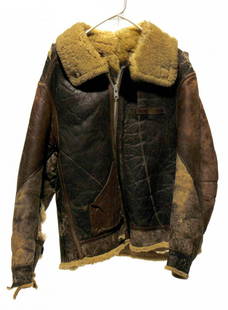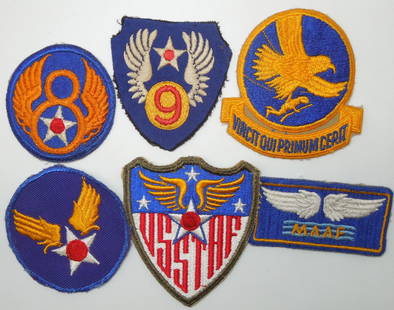
WWII US ARMY AIR CORPS 5TH AIR FORCE JACKET WW2
Similar Sale History
View More Items in Militaria & War Memorabilia

Related Militaria & War Memorabilia
More Items in Militaria & War Memorabilia
View MoreRecommended Collectibles
View More






Item Details
Description
WWII 5th Air Force named tunic with theater made bullion 5th Air Force Shoulder Sleeve Insignia. Tunic is also adorned with Corporal Chevrons. Tunic is size marked 36R along with the partial ASN: J-6563. Excellent. History: Fourteen Boeing B-17 Flying Fortresses that survived the Battle of the Philippines left Mindanao for Darwin, Australia, between 17 and 20 December 1941, the only aircraft of the Far East Air Force to escape. After its evacuation from the Philippines on 24 December 1941, FEAF headquarters moved to Australia and was reorganized and redesignated 5 Air Force on 5 February 1942, with most of its combat aircraft based on fields on Java. It seemed at the time that the Japanese were advancing just about everywhere. The remaining heavy bombers of the 19th Bombardment Group, based at Malang on Java, flew missions against the Japanese in an attempt to stop their advance. They were joined in January and February, two or three at a time, by 37 B-17Es and 12 LB-30s of the 7th Bombardment Group. The small force of bombers, never numbering more than 20 operational at any time, could do little to prevent the invasion of the Netherlands East Indies, launching valiant but futile attacks against the masses of Japanese shipping, with six lost in combat, six in accidents, and 26 destroyed on the ground. The 7th Bombardment Group was withdrawn to India in March 1942, leaving the 19th to carry on as the only B-17 Fortress-equipped group in the South Pacific. About this time it was decided that replacement B-17s would not be sent to the southwest Pacific, but be sent exclusively to the Eighth Air Force which was building up in England. By May, Fifth Air Force's surviving personnel and aircraft were detached to other commands and the headquarters remained unmanned for several months, but elements played a small part in the Battle of the Coral Sea (7–8 May 1942) when the 435th Bomb Squadron of the 19th Bomb Group saw the Japanese fleet gathering in Rabaul area nearly two weeks before the battle actually took place. Because of the reconnaissance activity of the 435th Bomb Squadron, the US Navy was prepared to cope adequately with the situation. The squadron was commended by the US Navy for its valuable assistance not only for its excellent reconnaissance work but for the part played in the battle. Headquarters Fifth Air Force was re-staffed at Brisbane, Australia on 18 September 1942 and placed under the command of Major General George Kenney. United States Army Air Forces units in Australia, including Fifth Air Force, were eventually reinforced and re-organised following their initial defeats in the Philippines and the East Indies. At the time that Kenney had arrived, Fifth Air Force was equipped with three fighter groups and five bombardment groups. Fighter Groups: 8th FG (P-39) Townsville, Australia 35th FG (P-40) Port Moresby, New Guinea 49th FG (P-40) Darwin, Australia Bomber Groups: 3rd BG (B-25, A-20, & A-24) Charters Towers, Australia 19th BG (Non-Operational. Battle scarred from Philippines & Java) Mareeba, Australia 22nd BG (B-26) Woodstock, Australia 38th BG (B-25) Charters Towers, Australia 43rd BG (B-17 until 1943; B-24 1943–1945) Port Moresby, New Guinea In addition, Fifth Air Force controlled two transport squadrons and one photographic squadron comprising 1,602 officers and 18,116 men. Kenney was later appointed commander of Allied air forces in the South West Pacific Area, reporting directly to General Douglas MacArthur. Under Kenney's leadership, the Fifth Air Force and Royal Australian Air Force provided the aerial spearhead for MacArthur's island hopping campaign. US Far East Air Forces: On 4 November 1942, the Fifth Air Force commenced sustained action against the Japanese in Papua New Guinea and was a key component of the New Guinea campaign (1942–1945). Fifth Air Force engaged the Japanese again in the Philippines campaign (1944–45) as well as in the Battle of Okinawa (1945). Fifth Air Force along with Thirteenth Air Force in the Central Pacific and Seventh Air Force in Hawaii were assigned to the newly created United States Far East Air Forces (FEAF) on 3 August 1944. FEAF was subordinate to the U.S. Army Forces Far East and served as the headquarters of Allied Air Forces Southwest Pacific Area. By 1945, the three numbered air forces were supporting operations throughout the Pacific. FEAF was the functional equivalent in the Pacific of the United States Strategic Air Forces (USSTAF) in the European Theater of Operations. Order of battle, 1945: Fifth U.S. Air Force Zones of Responsibility, 1945–1947 V Fighter Command Night Fighter Units V Bomber Command Photo Reconnaissance 54th Troop Carrier Wing 3d ACG (P-51, C-47) 418th NFS 3d BG (L) (B-25, A-20) 6th RG (F-5, F-7) 2d CCG 8th FG (P-40, P-38) 421st NFS 22d BG (M/H) (B-26 – B-24) 71st RG (B-25) 317th TCG 35th FG (P-47, P-51) 547th NFS 38th BG (M) (B-25) 374th TCG (1943 only) 49th FG (P-40, P-47, P-38) 43d BG (H) (B-24) 375th TCG 58th FG (P-47) 90th BG (H) (B-24) 433d TCG 348th FG (P-47, P-51) 312th BG (L) (A-20) 475th FG (P-38) 345th BG (M) (B-25) 380th BG (H) (B-24) 417th BG (L) (A-20) LEGEND: ACG – Air Commando Group, FG – Fighter Group, NFS – Night Fighter Squadron, BG (L) – Light Bomb Group, BG (M) – Medium Bomb Group, BG (H) – Heavy Bomb Group, RG – Reconnaissance Group, CCG – Combat Cargo Group, TCG – Troop Carrier Group When the war ended, Fifth Air Force had an unmatched record of 3,445 aerial victories, led by the nation's two top fighter aces Major Richard Bong and Major Thomas McGuire, with 40 and 38 confirmed victories respectively, and two of Fifth Air Force's ten Medal of Honor recipients. Shortly after World War II ended in August, Fifth Air Force relocated to Irumagawa Air Base, Japan, about 25 September 1945 as part of the Allied occupation forces. The command remained in Japan until 1 December 1950 performing occupation duties.
Buyer's Premium
- 20%
WWII US ARMY AIR CORPS 5TH AIR FORCE JACKET WW2
Estimate $200 - $300
5 bidders are watching this item.
Get approved to bid.
Shipping & Pickup Options
Item located in Willoughby, OH, usOffers In-House Shipping
Local Pickup Available
Payment

Related Searches
TOP


























































![[CIVIL WAR]. [BELL, William H., photographer]. CDV of a wounded soldier identified as Private George: [CIVIL WAR]. [BELL, William H., photographer]. CDV of a wounded soldier identified as Private George Ruoss, 7th New York Veteran Infantry, featured naked below the waist. CDV on cardstock mount (light](https://p1.liveauctioneers.com/197/329785/177758300_1_x.jpg?height=310&quality=70&version=1715625218)


















